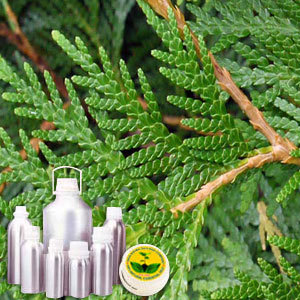Botonical Name | : | Thuja Occidentalis | |
CAS # | : | 8007-20-3 | |
Country of Origin | : | India | |
Color & Odor | : | Yellow to brown color with fresh woody aroma | |
Solubility | : | Soluble in alcohol and oils, Insoluble in water | |
Specific Gravity | : | 0.9060 - 0.9160 @ 20°C. | |
Optical Rotation | : | N.A. | |
Refractive Index | : | 1.4560 - 1.4600 @ 20°C | |
Flash Point | : | >100°C | |
Major Constituents | : | Thujone | |
Plant Part Used | : | Leaves | |
Extraction Method | : | Steam Distillation |
DESCRIPTION:
Belonging to cypress or Cupressaceae species of trees, Thuja tree has flat shaped side shoots and 1mm to 10 mm long scale like leaves. The shape of its leaves resembles to needles when the tree reaches to its first year. This coniferous tree is the source of Thuja Oil which is known for its expectorant, emmenagogue, rubefacient, insect repellent, diuretic, vermifuge and astringent attributes. This oil has stimulating effects on cardiac, uterus and nerve muscles. Tonic made of this oil has numerous health benefits. This oil is also used to produce fragrance for laundry detergents, soaps, cosmetics and personal care products for its mesmerizing aroma. CONSTITUENTS:
Sabinene, Fenchone, Alpha-Thujone, Beta-Thujone, Bornyl Acetate Gamma-Terpinene, Limonene, Alpha-Pinene, AROMATIC SUMMARY / NOTE / STRENGTH OF AROMA:
Top note intense smell of this oil has long lasting refreshing effects on mind. To be precise, its smell has similarity with the aroma of camphor and wood extracted oils. BLENDS WITH:
Thuja Essential Oil can be mixed with Cedar wood, Lavender, Citrus, Armoise and Pine Needle oils. COMMON NAMES:
Thuja Oil [Thuja Occidentalis] is popularly referred as tree of life, eastern white cedar, northern white cedar, Swamp cedar, American arborvitae and white cedar oil. USES:
Thuja Oil is a reliable remedy for complications of respiratory tract. This oil is effective in reducing hair fall.


































